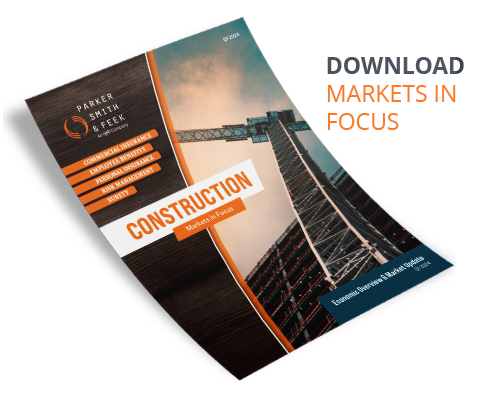Markets in Focus :: Construction Q1 2024
March 14, 2024
The IMA National Construction Group gathers to analyze construction economic data, weaving together insights that could influence risk and insurance strategies for construction firms. In specific scenarios, the construction sector thrives even amid a general economic downturn, thanks to lag time between project initiation and completion, sustaining active spending by owners. Conversely, there are instances where the overall economy is booming, but the construction sector is in decline. The availability and potential of projects for contractors are intricately tied to spending dynamics, with the broader economy influencing owners’ decisions to undertake construction projects.
To get a well-rounded picture of the current state of the construction economy, we look at construction spending, labor, and the cost of construction materials, followed by indicators that will give insight into future expectations. Our future state indicators include backlog, construction starts, ConstructConnect’s Project Stress Index and Expansion Index, and the Architectural Billings Index.
Learn more in the latest Construction Markets in Focus.
Resources and References
- Lagman, R. (2023, September 7). Default risk – Electrical contractors in a bind. AXAXL. axaxl.com/fast-fast-forward/articles/default-risk_electrical-contractors-in-a-bind
- U.S. Census Bureau. (2024, March 1). Construction Spending – December 2023. census.gov/construction/c30/current/index.html
- Federal Reserve Bank of St. Louis. (n.d.). Total Public Construction Spending. fred.stlouisfed.org/series/TLPBLCONS
- Associated Builders and Contractors. (2024, January 12). ABC Monthly Construction Input Prices Fall Sharply in December. abc.org/News-Media/News-Releases/abc-monthly-construction-input-prices-fall-sharply-in-december
The views and opinions expressed within are those of the author(s) and do not necessarily reflect the official policy or position of Parker, Smith & Feek. While every effort has been taken in compiling this information to ensure that its contents are totally accurate, neither the publisher nor the author can accept liability for any inaccuracies or changed circumstances of any information herein or for the consequences of any reliance placed upon it.


